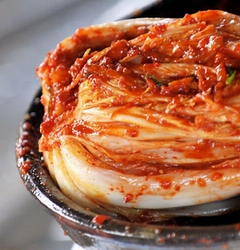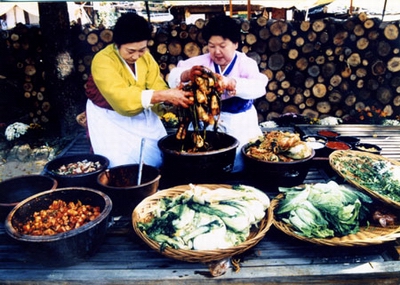 Kimchi is not unique. Other culinary traditions have their own ways of salting or pickling vegetables such as suancai (or paocai) in China, tsukemono in Japan, and sauerkraut in Germany.
Kimchi is not unique. Other culinary traditions have their own ways of salting or pickling vegetables such as suancai (or paocai) in China, tsukemono in Japan, and sauerkraut in Germany. But it is unique in the sense that it is deeply rooted in “gimjang,” an annual seasonal practice that involves family members and neighbors in making massive quantities of kimchi to be consumed during the long, harsh winters here. It reflects Korean society’s “sharing culture” with neighbors or the underprivileged, and still remains as a strong living tradition among modern-day Koreans.
Kimchi is one of the most renowned Korean side-dishes alongside main meals “bulgogi” (Korean barbeque) and “bibimbap” (mixed-rice topped with vegetables). Korean-style preserved vegetables seasoned with local spices and fermented seafood were first recorded as part of the Korean diet as early as 760 years ago. Kimchi is a must-have side-dish at all Korean meals and many Koreans believe that the most luxurious banquet is incomplete without kimchi.
The Cultural Heritage Administration (CHA) submitted a report on “Gimjang, Making and Sharing Kimchi” for UNESCO’s Intangible Cultural Heritage of Humanity list which will be decided in Baku, Azerbaijan from Dec. 2 through 8.
UNESCO adopted a treaty for the Convention Safeguarding Intangible Cultural Heritage in 2003. Under this, traditional arts and craftsmanship as well as social customs and knowledge can be protected as intangible heritages. While the Korean government and parts of society are striving to protect traditional kimchi making practices and recipes, which are diverse according to regions, various reasons why Kimchi making should be on UNESCO’s list are being discussed.
Park Young-geun, a high-ranking official of the CHA, said that a submission report focused on today’s gimjang customs. “It is true that the amount of consumption of kimchi nowadays is decreasing. But we can frequently see kimchi on our table,” he said.
As the Korean folk song “Arirang” was registered on UNESCO’s Intangible Cultural Heritage of Humanity list recently for its contribution to encouraging social solidarity as part of community activity today, gimjang has many reasons to become the next international heritage representing Korea.
It's gimjang, not kimchi
Although various regional recipes for kimchi are well-known, attempts to shed light on kimchi from a cultural perspective have been few. Gimjang or a seasonal kimchi making practice is technically speaking a kind of cultural activity which takes place at the threshold of winter in collaboration with villagers and family members. It is a long-held tradition in Korean society which has been continued until today, albeit on and off, and remains as a strong legacy of community-involved activities.
Gimjang reflects Koreans’ interactions in the past with the natural environment ― surviving with scant food in the long, harsh winter, and so developing salted fermentation for long preservation. Geographic conditions also diversify kimchi recipes in each region with various ingredients marking regional flavors. The recipes can be altered according to the tastes of the makers, so foreigners can easily make kimchi palatable to them.
Gimjang requires a yearly seasonal cycle. In spring, shrimp, anchovy, and other seafood should be prepared for salting and fermenting. In summer, sea salt which is stored for up to two or three years should be acquired to let the bitter taste of brine out. In late summer, red chili peppers are dried and ground into powder. In late autumn, kimchi makers wait weather forecasts for the best dates for gimjang because it is important to make kimchi at the right temperature to acquire the best taste.

Local white-good electronics companies are quick to release their brand new refrigerators dedicated to kimchi as present-day Koreans rarely use the earthen jars to store kimchi.
Kimchi refrigerators, a relatively recent invention in the local electronics market, owned by over 80 percent of Korean households, show how modern-day Koreans still live in a kimchi-related cuisine culture.
The CHA said that kimchi is a unique culinary culture but closely related to the nation’s openness to outside cultures as it has developed various recipes adopting foreign ingredients such as cabbages and red peppers.
Community-involved, sharing culture
The CHA said that gimjang has played a “gender mitigator” in traditional society where men didn’t help women with kitchen chores. But when making kimchi in this season, men helped women in hauling and washing vegetables and digging a hole for burying the jars to store kimchi. Such a helping spirit can be found in sharing with others in today’s society.
As the gimjang season nears, communities are busy holding large-scale kimchi making events to share it with the underprivileged and the multicultural family members.
Nowadays, although the amount of the kimchi consumption is decreasing and kimchi is available in supermarkets, many households are still making their own kimchi.
According to a survey in November 2011 by CHA, about 95 percent of Koreans eat kimchi at least once a day; about 64 percent eat it three times a day. More than 70 percent are involved themselves in gimjang.
Amid widespread urbanization and westernization of eating habits, gimjang is becoming a crucial opportunity for strengthening family cooperation and solidarity in modern society. While making and sharing kimchi through collective labor, it encourages people to share ideas.





